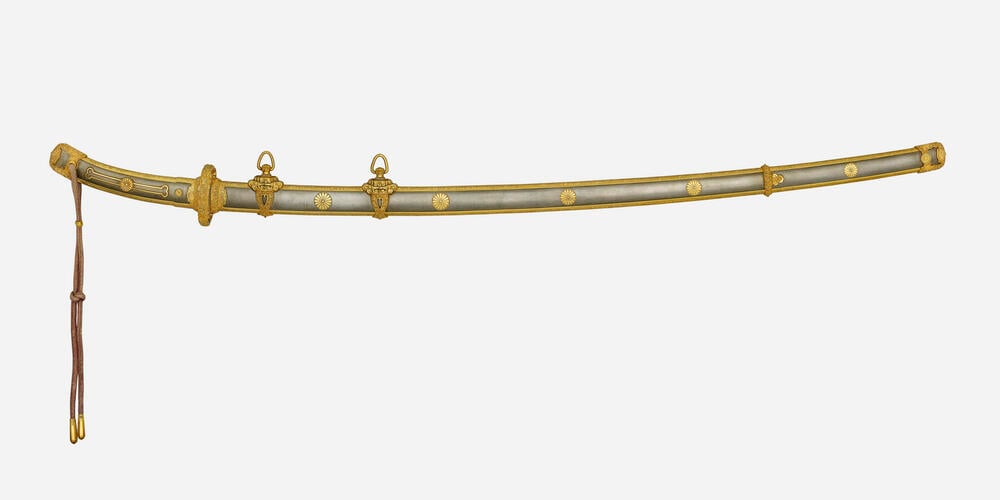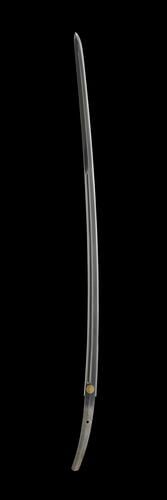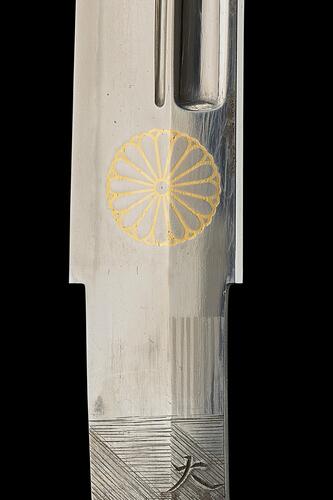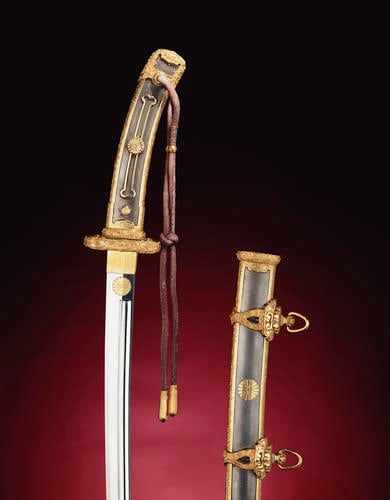-
1 of 253523 objects
Field Marshal's sword (gensuitō), scabbard and case blade signed and dated 1918
Steel, shakudō, shibuichi, gold, silver, leather | 6.5 cm (Width) x 7.0 cm (Depth); 93.0 cm (Length) (sword and scabbard) (whole object) | RCIN 62630

Gassan Sadakazu (1836-1918)
Master: Field Marshal's sword (gensuitō), scabbard and case blade signed and dated 1918

Gassan Sadakazu (1836-1918)
Master: Field Marshal's sword (gensuitō), scabbard and case blade signed and dated 1918

Gassan Sadakazu (1836-1918)
Master: Field Marshal's sword (gensuitō), scabbard and case blade signed and dated 1918

Gassan Sadakazu (1836-1918)
Master: Field Marshal's sword (gensuitō), scabbard and case blade signed and dated 1918





-
This is the only known sword of its kind outside Japan. It is a gensuitō – a formal sword given by the emperor to those of the rank of Field Marshal (Dai Gensui) or Admiral. In the Meiji period there were only eight such awards; in the Taishō period there were 12. This example was a diplomatic gift to King George V from the Emperor Taishō, carrying with it the honorary rank of Dai Gensui.
The elegant blade has a straight, misty-edged tempering pattern (suguha hamon). It is made in the style of the earliest recorded Japanese blade to have a deliberately forged curve. That blade, known as Kogarasu Maru (the ‘Little Crow’), is in the collection of the Japanese Imperial Household. It is believed to have been forged by the semi-legendary smith Amakuni, who may have lived in Yamato Province during the eighth century.
The scabbard and mounts are of the finest quality, and both the scabbard and hilt have a wooden core covered with the copper–silver alloy shibuichi. The borders of the scabbard and hilt are of gold, engraved with scrolling chrysanthemums. The hilt is of the style called kenuki-gata (‘tweezer-shaped’) and the ‘tweezers’ are inset with the 16-petalled imperial chrysanthemum, which can also be seen on the scabbard between the suspension fittings. Originally the hilt would be cut through with a longitudinal slot, which may have been a device to absorb some of the shock received by the sword when cutting.
The blade is inscribed with the signature of Gassan Sadakazu, who in 1906 was appointed Imperial Household Artist (Teishitsu Gigei’in). The only published account of this blade speculates that it was in fact made by his son, Gassan Sadakatsu. This is based on the rather slim speculation that one stroke of the first character ‘Sada’ has been cut in a style more like that of Sadakatsu. However, it seems highly unlikely that a blade for such an important diplomatic gift would have been entrusted to the son and not made by the Imperial Craftsman himself.
Text adapted from Japan: Courts and Culture (2020)Provenance
Presented to King George V by Prince Yorihito of Higashi-Fushimi on behalf of Emperor Yoshihito of Japan, 29 October 1918. This is the only sword of its type outside Japan.
Presented with a gold sword belt (RCIN 62058). -
Creator(s)
(bladesmith)(nationality)Acquirer(s)
-
Medium and techniques
Steel, shakudō, shibuichi, gold, silver, leather
Measurements
6.5 cm (Width) x 7.0 cm (Depth); 93.0 cm (Length) (sword and scabbard) (whole object)
13.2 x 106.0 x 18.3 cm (storage box) (whole object)
Place of Production
Japan